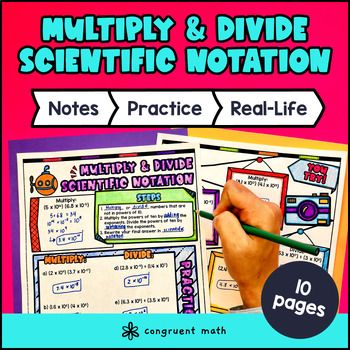Want more ideas and freebies?
Get my free resource library with digital & print activities—plus tips over email.
Join for free resources →
$4.25
Ever wondered how to teach multiplying and dividing numbers in scientific notation in an engaging way to your eighth-grade students?
In this lesson plan, students will learn about scientific notation and its real-life applications. Through artistic, interactive guided notes, maze activity, a doodle & color by number activity, and a maze worksheet, students will gain a comprehensive understanding of multiplying and dividing numbers in scientific notation.
The lesson culminates with a real-life application activity where students read and reflect about real-life uses of scientific notation.

$4.25
After this lesson, students will be able to:
Before this lesson, students should be familiar with:
As a hook, ask students why scientific notation is important in real life situations. You can prompt them to think about situations where very large or very small numbers are involved, such as the distance between planets, the weight of atoms, or the population of cities. Refer to the real-life application section on the last page of the guided notes as well as the FAQs below for ideas.
Use the first page of the guided notes to introduce the concept of multiplying and dividing numbers in scientific notation. Walk through the key points of multiplying numbers in scientific notation, including how to multiply the coefficients and add the exponents.
Based on student responses, reteach the concept of multiplying numbers in scientific notation that students may need extra help with. If your class has a wide range of proficiency levels, you can pull out students for reteaching, and have more advanced students begin work on the practice exercises.
Have students practice multiplying and dividing numbers in scientific notation using the practice worksheets (maze and color by number activity in the guided notes). Walk around to answer student questions.
Bring the class back together, and introduce the concept of real-life uses of scientific notations. Explain that scientific notation is commonly used in scientific fields such as astronomy, physics, and chemistry. It is a way to express very large or very small numbers in a more convenient and concise format.
If you’re looking for digital practice for multiplying and dividing numbers in scientific notation, try my Pixel Art activities in Google Sheets. Every answer is automatically checked, and correct answers unlock parts of a mystery picture. It’s incredibly fun, and a powerful tool for differentiation.
Here are activities to explore:
A fun, no-prep way to practice multiplying and dividing numbers in scientific notation is Doodle Math — they’re a fresh take on color by number or color by code. It includes multiple levels of practice, perfect for a review day or sub plan.
Here are 2 activities to try:
Scientific notation is a way to express very large or very small numbers using a combination of a number between 1 and 10, multiplied by a power of 10.
To multiply numbers in scientific notation, multiply the decimal parts of the numbers together and add the exponents of the powers of 10.
Sure! Here's an example: (3.4 x 10^6) * (2.5 x 10^3) = (3.4 * 2.5) x 10^(6+3) = 8.5 x 10^9
To divide numbers in scientific notation, divide the decimal parts of the numbers and subtract the exponent of the denominator from the exponent of the numerator.
Of course! Here's an example: (2.2 x 10^8) / (5 x 10^2) = (2.2 / 5) x 10^(8-2) = 0.44 x 10^6
Scientific notation allows us to efficiently write and work with very large or very small numbers.
Scientific notation is used in various fields such as astronomy, physics, chemistry, and engineering to express measurements of extremely large or small quantities.
Yes! Here are some helpful tips:
Get my free resource library with digital & print activities—plus tips over email.
Join for free resources →